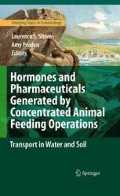Abstract
The steroid hormones are phylogenetically very old and nature has developed numerous mechanisms for their decomposition. However, the huge volume of steroids generated from CAFOs and the appearance of hormones in streams and rivers requires that possible environmental impact needs to be assessed.
Access this chapter
Tax calculation will be finalised at checkout
Purchases are for personal use only
References
Casey FXM, Šimůnek J, Lee J, Hakk H, Larsen GL (2005) Sorption, mobility, and transformation of estrogenic hormones in natural soil. J Environ Qual 34:1372–1379
Carson JD, Jenkins RL, Wilson EM, Howell WM, Moore R (2008) Naturally occurring progesterone in loblolly pine (Pinus taeda l.): a major steroid precursor of environmental androgens. Environ Toxicol Chem 27:1273–1278
Choi HS, Kiesenhofer E, Gantner H, Hois J, Bamberg E (1987) Pregnancy diagnosis in sows by estimation of oestrogens in blood, urine or faeces. Anim Reprod Sci 15:209–216
Díaz-Cruz MS, Barceló D (2007) Recent advances in LC-MS residue analysis of veterinary medicines in the terrestrial environment. Trends Anal Chem 26:637–646
Díaz-Cruz MS, López de Alda MJ, Barceló D (2003) Environmental behavior and analysis of veterinary and human drugs in soils, sediments and sludge. Trends Anal Chem 22:340–351
Fine DD, Breidenbach GP, Price TL, Hutchins SR (2003) Quantitation of estrogens in ground water and swine lagoon samples using solid-phase extraction, pentafluorobenzyl/trimethylsilyl derivatizations and gas chromatography–negative ion chemical ionization tandem mass spectrometry. J Chromatogr A 1017:167–185
Furuichi T, Kannan K, Suzuki K, Tanaka S, Giesy JP, Masunaga S (2006) Occurrence of estrogenic compounds in and removal by a swine farm waste treatment plant. Environ Sci Technol 40:7896–7902
Hakk H, Millner P, Larsen G (2005) Decrease in water-soluble 17β-estradiol and testosterone in composted poultry manure with time. J Environ Qual 34:943–950
Hajek RA, Rober AD, Johnston DA, Van NT, Tcholakian RK, Wagner LA, Conti CJ, Meistrich ML, Contreras N, Edwards CL, Jones LA (1997) During development, 17 α-estradiol is a potent estrogen and carcinogen. Environ Health Prospect 105(Suppl. 3):577–581
Hoffmann B, Gopes de Pinho T, Shuler G (1999) Determination of free and conjugated oestrogens in peripheral blood plasma, feces and urine of cattle throughout pregnancy. Exp Clin Endocrinol Diabetes 105:296–303
Kolodziej EP, Gray JL, Sedlak DL (2003) Quantification of steroid hormones with pheromonal properties in municipal wastewater effluent. Environ Toxicol Chem 22:2622–2629
Kolodziej EP, Harter T, Sedlak DL (2004) Dairy wastewater, aquaculture, and spawning fish as sources of steroid hormones in the aquatic environment. Environ Sci Technol 38:6377–6384
Lorenzen A, Hendel JG, Conn KL, Bittman S, Kwabiah AB, Lazarovitz G, Massé D, McAllister TA, Topp E (2004) Survey of hormone activities in municipal biosolids and animal manures. Environ Toxicol 19:216–225
Miller CW (1996) Progestin analysis by gas chromatography/mass spectrometry in plasma and feces of horses, cattle, and sheep. Thesis, Oregon State University, Corvallis, OR
Millspaugh JJ, Washburn BE (2004) Use of fecal glucocorticoid metabolite measures in conservation biology research: considerations for application and interpretation. Gen Comp Endocrinol 138:189–199
Möstl E, Dorbretsberger A, Palme R (1997) Östrogenkonzentration im stallmist trächtiger rinder. Wien Tierärztl Mschr 84:140–143
Nichols DJ, Daniel TC, Moore A, Edwards DR, Pote DH (1997) Runoff of estrogenic hormone 17β-estradiol from poultry litter applied to pasture. J Environ Qual 26:1002–1006
Palme R, Fischer P, Schildorfer H, Ismail MN (1996) Excretion of infused 14C-steroid hormones via faeces and urine in domestic livestock. Anim Reprod Sci 43:43–63
Raman DR, Williams EL, Layton AC, Burns RT, Easter JP, Daugherty AJ, Mullen D, Sayler GS (2004) Estrogen content of dairy and swine wastes. Environ Sci Technol 38:3567–3573
Schwarzenberger F, Möstl E, Palme R, Bamberg E (1996) Faecal steroid analysis for non-invasive monitoring of reproductive status in farm, wild and zoo animals. Anim Reprod Sci 42:515–526
Shore LS, Harel-Markowitz E, Gurevich M, Shemesh M (1993) Factors affecting the concentration of testosterone in poultry litter. J Environ Sci Health A28:1737–1749
Shore LS, Shemesh M (1993) Analysis of testosterone levels in chicken manure. Isr J Vet Med 48:35–37
Soto AM, Sonnenschein C, Chung KL, Fernandez MF, Olea N, Serrano FO (1995) The E-screen assay as a tool to identify estrogens: an update on estrogenic environmental pollutants. Environ Health Perspect 103:133–122
Sorensen PW, Pinillos M, Scott AP (2005) Sexually mature male goldfish release large quantities of androstenedione into the water where it functions as a pheromone. Gen Comp Endocrinol 140:164–75
The Ohio State University Extension (2006) Ohio livestock manure management guide 604. http://ohioline.osu.edu/b604/index.html . Accessed 7 Aug 2008
Thompson ML (2005) Persistence and pathways of 17β-estradiol in agricultural soils: a field study. Master’s thesis, North Dakota State University, Fargo ND
Turner CW (1947) The male hormone content of ruminant manure. J Dairy Sci 30:1–8
USDA-ERS (2007) Livestock, dairy, and poultry outlook/LDP-M-152/Feb. 20 2007. Economic Research Service, Washington, DC. http://www.ers.usda.gov/Publications/LDP/2007/02Feb/ldpm152tables.pdf . Accessed 7 Aug 2008
USDA-NASS (2006) Quarterly hogs and pigs. Agricultural Statistics Board, Washington, DC. http://usda.mannlib.cornell.edu/usda/nass/HogsPigs//2000s/2006/HogsPigs-12-27-2006.pdf?bcsi_scan_9836791FF96CD3A5=0&bcsi_scan_filename=HogsPigs-12-27-2006.pdf . Accessed 7 Aug 2008
Vethaak AD, Rijs GBJ, Schrap SM, Ruiter H, Gerritsen A, Lahr J (2002) Estrogens and xeno-estrogens in the aquatic environment of the Netherlands RIZA/RIKZ-Report no. 2001.028. National Institute for Coastal and Marine Management (RIKZ), The Hague, Netherlands
Vos EA (1996) Direct ELISA for estrone measurement in the feces of sows: prospects for rapid, sow-side pregnancy diagnosis. Theriogenology 46:211–231
Wenzel A, Kuechler Th, Mueller J (1998) Konzentrationen oestrogen wirksamer Substanzen in Umweltmedien. Report. Project sponsored by the German Environmental Protection Agency, Project No. 216 02 011/11
Author information
Authors and Affiliations
Corresponding author
Editor information
Editors and Affiliations
Rights and permissions
Copyright information
© 2009 Springer Science+Business Media, LLC
About this chapter
Cite this chapter
Shore, L. (2009). Steroid Hormones Generated by CAFOs. In: Pruden, A., Shore, . (eds) Hormones and Pharmaceuticals Generated by Concentrated Animal Feeding Operations. Emerging Topics in Ecotoxicology, vol 1. Springer, New York, NY. https://doi.org/10.1007/978-0-387-92834-0_3
Download citation
DOI: https://doi.org/10.1007/978-0-387-92834-0_3
Published:
Publisher Name: Springer, New York, NY
Print ISBN: 978-0-387-92833-3
Online ISBN: 978-0-387-92834-0
eBook Packages: Earth and Environmental ScienceEarth and Environmental Science (R0)

